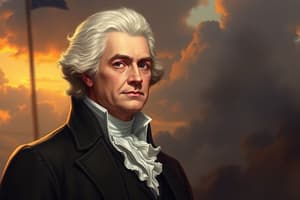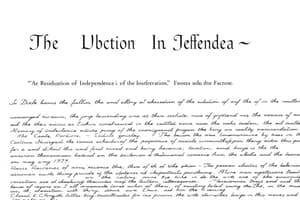Podcast
Questions and Answers
What man wrote the Declaration of Independence?
What man wrote the Declaration of Independence?
Thomas Jefferson
What group signed the Declaration of Independence and when do we celebrate it? (Month, day, and year)
What group signed the Declaration of Independence and when do we celebrate it? (Month, day, and year)
2nd Continental Congress, July 4th, 1776
What is Part 1 of the Declaration of Independence?
What is Part 1 of the Declaration of Independence?
Statement of Purpose
What does Part 2 of the Declaration of Independence state?
What does Part 2 of the Declaration of Independence state?
What is stated in Part 3 of the Declaration of Independence?
What is stated in Part 3 of the Declaration of Independence?
What does Part 4 of the Declaration of Independence list?
What does Part 4 of the Declaration of Independence list?
What is Part 5 of the Declaration of Independence?
What is Part 5 of the Declaration of Independence?
Flashcards are hidden until you start studying
Study Notes
Key Figures and Dates
- Thomas Jefferson authored the Declaration of Independence.
- The 2nd Continental Congress signed the document on July 4th, 1776, a date celebrated annually as Independence Day.
Part 1: Statement of Purpose
- This section emphasizes the necessity for the colonists to explain their reasons for separating from England's governance to the global community.
Part 2: Statement of Rights of People
- Asserts that individuals are born with inalienable rights, including life, liberty, and the pursuit of happiness.
- Contains the pivotal phrase "All men are created equal," highlighting the Equality principle.
Part 3: Statement of Government
- Establishes that governments are formed by the people to protect their rights.
- Affirms the right of the populace to alter or abolish a government that abuses its authority.
Part 4: List of Complaints
- Details grievances inflicted upon the colonists by King George III and Parliament.
- Includes instances where colonists attempted to address their issues with the King, paired with England's lack of effective responses.
- Some language within this list is notably hyperbolic.
Part 5: Statement of Independence
- Declares the colonies' freedom from British domination.
- Grants the colonies the authority to engage in war, establish treaties with foreign nations, and manage trade independently.
Studying That Suits You
Use AI to generate personalized quizzes and flashcards to suit your learning preferences.




